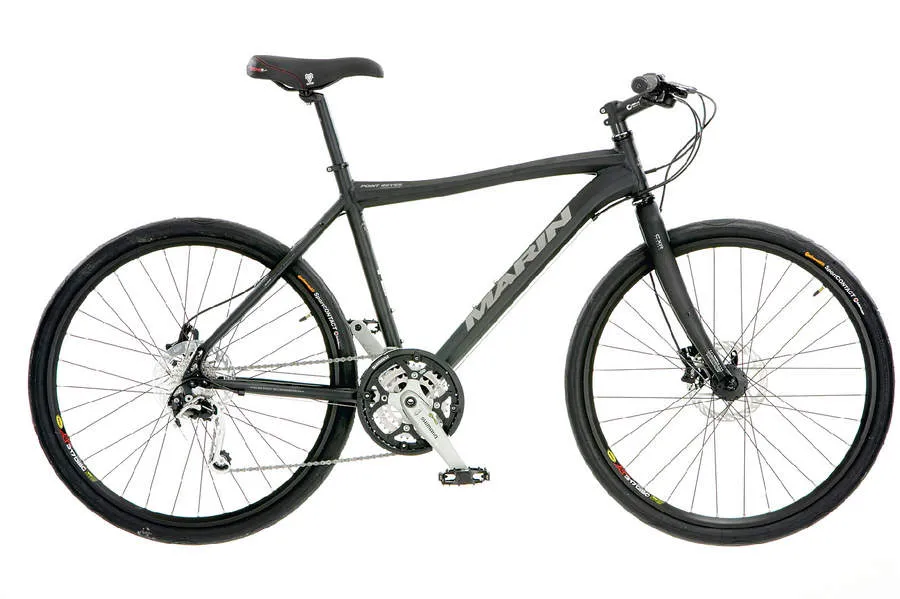With slick tyres any rigid mountain bike can be turned into a capable city bike, and for years now manufacturers have been selling such bikes off the peg. Marin has five in its urban range, and the Point Reyes is the flagship model.
- Frame and fork: Quality, lightweight mountain bike chassis with a carbon fibre fork, big clearances and the all-important eyelets for mudguards and carrier racks.
- Handling: Good tyre choice combines shock-absorbency with speed. The wide bar is more at home on technical singletrack than congested city streets.
- Equipment: Gearing mix gives a range like an easier road triple. Brakes are powerful, progressive, all-weather stoppers, regardless of load or terrain. Comes with platform pedals too.
- Wheels: Reliable, well sealed hubs and decent, eyeleted disc rims should last forever in the city, and the security skewers are nice, but 32 spokes isn’t ideal for heavy loads.
The Point Reyes' aluminium frame uses hydroformed tubing for the top tube and down tube. That means they’re shaped by high-pressure hydraulic fluid into flowing shapes with curves and concavities. Here they have an odd angular profile, which is largely aesthetic rather than structural, though the wider tube diameters at the head tube do increase stiffness.
Hydroforming can thin the tube walls, which would reduce strength, but these tubes are butted so there’s nothing to worry about. Practical touches include fittings for a carrier rack and a mudguard, something that the carbon fibre fork offers too, so you could use the Point Reyes as a loaded touring bike.
Gearing looks superficially like a standard 27-speed mountain bike setup. It isn’t. The Shadow XT rear derailleur is pure off-road bling. The straighter cable run to this mech reduces friction, so gearshifts should stay crisper for longer. Its other advantage – the fact that it tucks in 12mm closer to the wheel to reduce strikes on rocks – is redundant on road.
The crankset is from Shimano’s trekking range, meaning bigger chainrings to give fewer spinny gears on tarmac, while at the back end the 12-25-tooth cassette is straight from Shimano’s road range. Indexing is fine – all Shimano nine-speed cassettes have the same spacing. On road, the closer-spaced cassette lets you accelerate smoothly without spoiling your cadence. Off-road, though, or with heavy loads, the lack of really low gears is noticeable.
Hydraulic disc brakes offer a level of stopping power that’s almost overkill, but they’ll keep on working well if you end up riding in mud, snow or driving rain, and they won’t abrade your rims. Note that you’ll need a disc brake-specific rear rack if you decide to fit one, otherwise it’ll foul the rear calliper.
While 26in wheels don’t roll quite as efficiently as 700C ones, the Marin’s Continental Sport Contacts are slick and quick. They corner well too. Big clearances mean you could use lots of different tyres – Schwalbe Marathons, perhaps, for touring, or some 2in knobblies for serious off-road riding. Pentagonal-headed security skewers mean your wheels are less likely to get half-inched.
The Marin’s wide riser handlebar jars a little with the rest of the bike. You don’t need this extra leverage for riding on the road, and big bars are more likely to clip wing mirrors or gateposts. A narrower flat bar with bar ends would let you hunker down into the wind more to raise your pace, and improve hand comfort.
If there’s one issue with the Marin, it’s that it’s almost too nice for city streets. It’s a shame to subject an XT mech to the daily grind of commuting, and the bike’s good looks will make it tempting to thieves.
The Point Reyes is a capable urban bike, but its real strength is its versatility. Add some different tyres and trappings and you could use this bike for the weekday commute, weekend mountain biking (if you don’t mind its rigidity and bigger gears) and even touring. If you’ve got space for only one good bike, this might be it. It’s adaptable, light and tough.

